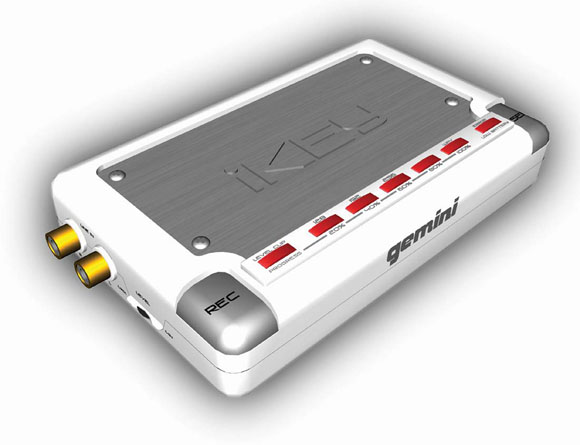
Yet another iPod . . . yet another iPod without real recording capability. (And no, adding a piece of hardware and then having to deal with low-resolution recording does not count.)
So while Nano is certainly deeply drool-worthy for listening, wouldn’t it be great to have an iPod-like device for recording? Here are some of your options:
Hack your iPod. iPodLinux unlocks full-resolution, uncompressed audio recording with no additional hardware; it works best with a line out plugged into the headphone port but mic recording works, too (though the signal winds up being on the weak side). Installation on Windows and Mac is easy; see links on their site. Bad news: many iPod models aren’t supported; my 3rd-gen iPod works great but 4G support and mini are still in the works — and forget about Nano.
Get an iKey and a hard drive. Gemini’s iKey recorder takes a line in input from RCA and records either MP3 or WAV to a USB key or hard drive. That makes it a good companion to an iPod Shuffle or Nano or, better yet, a high-capacity, full-blown iPod. Detailed specs now available from Gemini. And it’s got a clip indicator so you don’t screw up your recording. Bad news: The iKey could be great for someone whose only need is getting a line feed recorded, especially for extended recording sessions. But the thing is big and clunky (2 lbs, and about 5″ wide) and costly ($229 list) for something that really doesn’t do anything. It’s just a line in, USB out with buttons on it — no mic in, and no built-in storage. For the price, you could get an iPodLinux-compatible iPod, or save up for a real recorder. Speaking of which . . .

Get a decent CompactFlash recorder: This is really the best solution. There are a number of real recording devices that do accept mic input, even with mic pres / phantom power. My favorites of these are the Edirol R-1 and M-Audio MicroTrack (shown). The R-1 has lots of great extras, like a built-in stereo mic that sounds surprisingly good, mic effects, and metronome. The MicroTrack is more iPod-like in shape and has digital in (perfect for connecting to your audio interface.) Bad news: None, really, other than price — about $400 for the recorder, plus $100 for storage. But as opposed to the other routes, while this will cost you more, you’ll get a real serious recorder you can actually use. I’m still saving up for mine, but boy do I want one of those MicroTracks at my next gig.
Get Apple to Add Recording. This sure would be nice. Bad news: Outlook very, very poor.
Previous coverage: (and more details on these recorders)
Which Portable Recorder to Buy?
Gemini iKey Recorder: BYO Hard Drive
M-Audio MicroTrack Portable Recorder: Official, US$499.95
Edirol R-1, Tricked-Out Portable Recording
Korg D4 Compact Flash Four-Track USB Portable Recorder
Pro Digital Recorders with SMPTE Sync for Video Production
The “HD” MiniDisc – 1GB Recorders from Sony
Marantz PMD660 Portable Digital Recorder
Updated: Music thing joins the quest for recording alternatives, no matter how “cheap or ugly.” I’m game. And I’m on the lookout for a MicroTrack to test; stay tuned. Heck, if I get one, and you’re in the NYC area, we can test it on your band. -PK
Updated again: The Digital Music Weblog waxes poetic about an old Archos Jukebox Recorder . . . that’s gigantic and records MP3s, not lossless files. Hrmm, still not impressed. Who knew basic recording would prove to be an elusive technology?